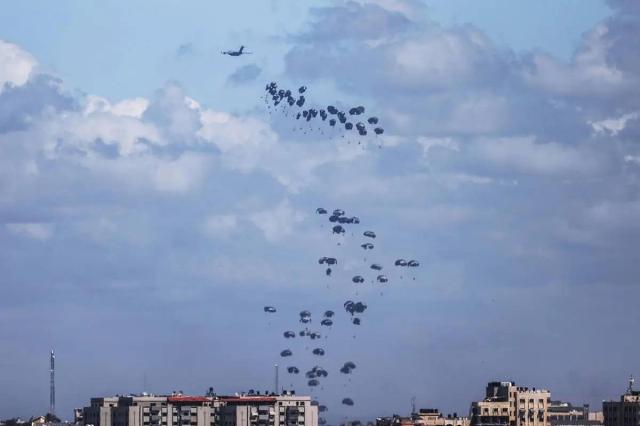A month after October 7, 2023, since the beginning of hostilities in the Gaza Strip, both humanitarian and military supplies began to be delivered by air by parachute landing. At the same time, at the initial stage, the transport aircraft of the Jordanian and Israeli Air Forces carried out point landing of cargo using guided gliding cargo parachute systems (USPGS).
So, during one week from November 6 to 11, 2023, Jordanian Air Force aircraft with the support of the United Arab Emirates (transferred cargo for delivery) twice carried out the landing of humanitarian supplies using the USPGS. The cargo includes medicines and medical equipment for the Jordanian field hospital, which has been operating in the Gaza Strip for several years, access to which was stopped with the outbreak of hostilities. According to representatives of the Jordanian Air Force, all cargo landed with high accuracy: about 75 m from the set landing point.
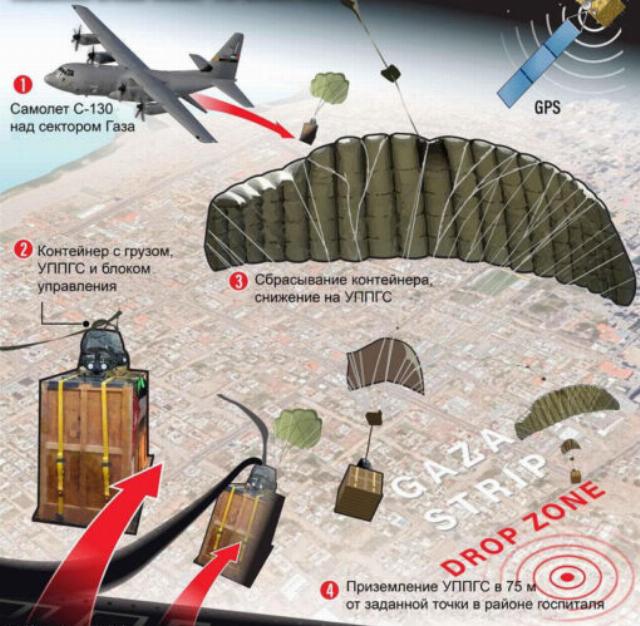
The scheme of application of the USPGS to provide a hospital in the Gaza Strip
In the future, military personnel and transport aircraft of the Air Forces of the Netherlands, France, Egypt and the United Arab Emirates joined the landing of humanitarian supplies. In some cases, up to six aircraft took off for landing at the same time, as a rule, from one of the air bases in Jordan. In total, from November 2023 to February 2024, about 20 cargo landings were carried out by aircraft of the above-mentioned countries in the Gaza Strip.
On December 11, 2023, the Israeli Air Force similarly delivered supplies (water, food) to several hundred soldiers of the IDF Ground Forces. In total, about seven tons of cargo were dropped at seven USPS. This was the first use of such parachute systems for the Israeli Armed Forces in a combat situation.
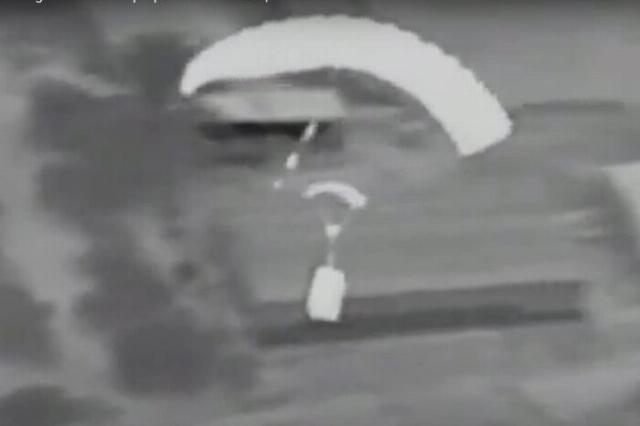
Landing cargo for the IDF in a combat situation
All cases of cargo landing are documented, photographs and video materials are available. In at least two cases, cargo dumping was controlled from an unmanned aerial vehicle.
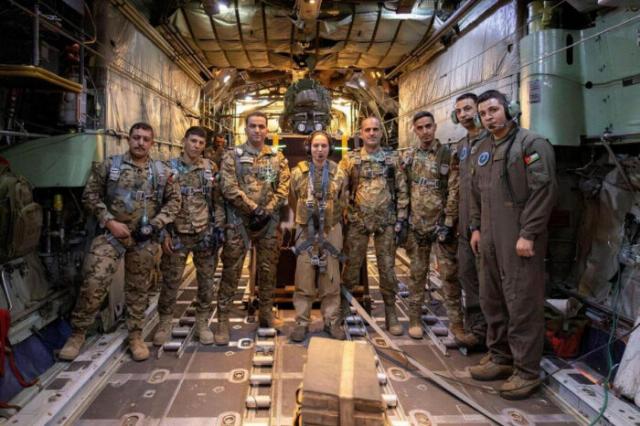
Princess Salman is among the crew of the Jordanian Air Force plane
An interesting fact is that members of the royal family of Jordan took part in the landing of cargo. So, in December 2023, one of the pilots of the Jordanian military transport aircraft was Princess Salma, the second daughter of the Jordanian king, who holds the military rank of first lieutenant of the Royal Jordanian Air Force.
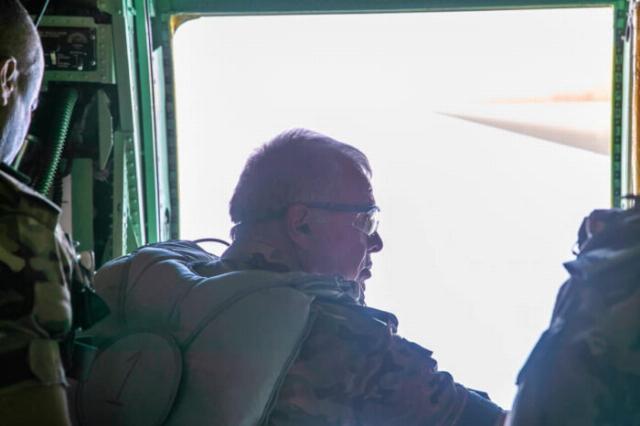
King Abdullah II of Jordan watches the approach to the landing site through a side door before dropping off cargo
King Abdullah II of Jordan himself, dressed in military uniform and wearing a rescue parachute, as befits a crew member, flew at least twice to escort the parachute landing of cargo in February 2024, including directly dropping small-sized PGS into the side door of the aircraft.
All cargo landings were carried out in coordination with the Israeli Armed Forces from a high altitude in order to avoid being hit by air defense systems, primarily man-portable air defense missile systems, of both the IDF and Hamas units.
Initially, cargo landing was carried out using reusable FireFly 2K USGS (maximum drop height – 7468 m, flight weight – 295-1089 kg, weight of the USGS with a control unit – 73.5 kg). In the future, due to the impossibility of selecting and returning expensive, reusable USGS, disposable USGS "FlyClops 2K" from the same manufacturer were used.
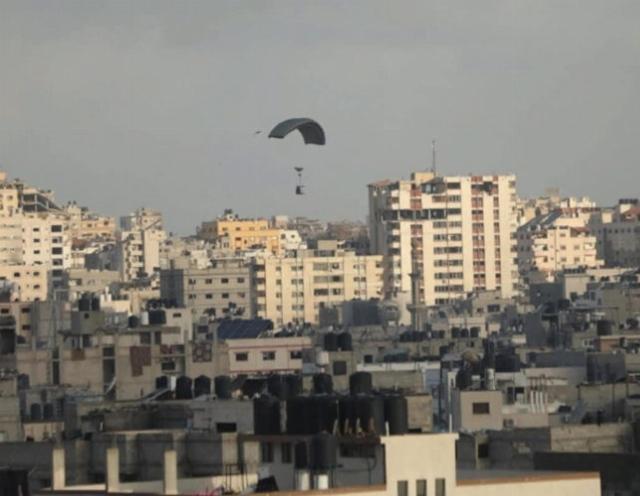
Reduction of the USGS "FlyClops 2K" over the Gaza Strip
Disposable USPS (dome and slings), as well as cargo fastening straps to the platform, are made of materials designed for single use. A simplified parachute control unit is used in a wooden case and with one electric motor for control lines. The flight weight is 318-998 kg, the maximum drop height is 5334 m, the mass of the USPGS with a control unit is 32.7 kg. The cost of a single-use USPGS is about 4-5 times cheaper than a reusable one. The planning range of both USGS after dropping is up to 25 km, the landing accuracy (circular probable deviation, CVO) is not worse than 150 m.
Since the Jordanian Armed Forces did not have a sufficient number of USPS, they were provided by the United Kingdom and the United States. The periodic use of USPGS was noted until the end of February 2024.
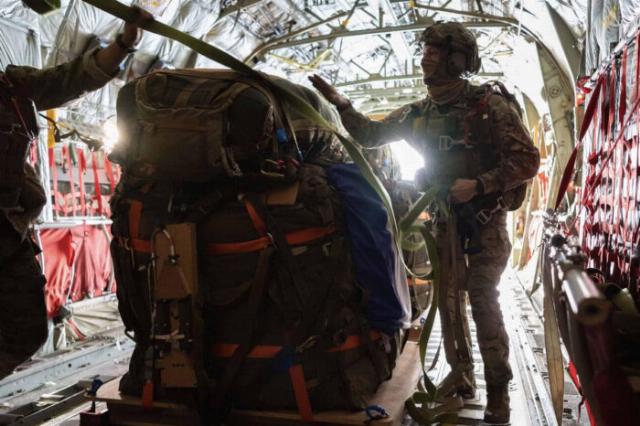
The French LMTGH-OB high-altitude landing PGS is ready to land in the Gaza Strip
On February 24, 2024, during the next parachute landing of humanitarian supplies from a French military transport aircraft, the uncontrolled parachute cargo system (LGS) of the high-altitude landing LMTGH-OB (Large de Matériel a Très Grande Hauteur en Ouverture Basse) was used. 2,200 kg of humanitarian supplies were dropped on two PGS.
Starting on March 2, 2024, the US Air Force began parachuting humanitarian supplies. Before that, they were limited to delivering goods to Egypt, which were then transported by road to the Gaza Strip. On March 2, three C-130J aircraft of the US Air Force dropped 66 single-use LCADS-LV (Low Cost Aerial Delivery System-Low Velocity) PGS, which, among other things, contained 38 thousand food rations.
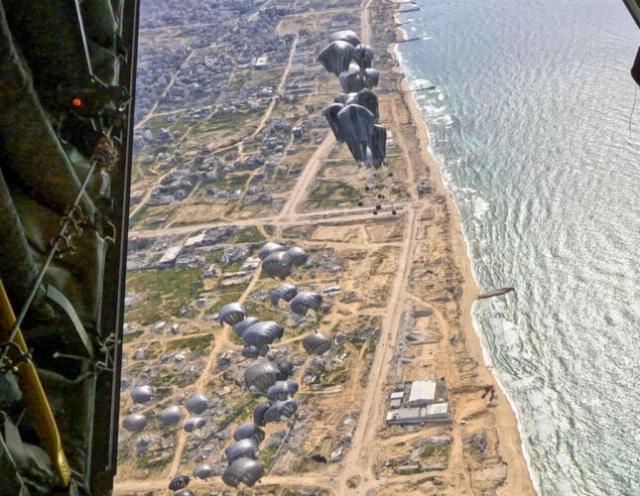
Cargo landing on LCADS-LV PGS near the coast
But unlike the high–altitude landing of cargo, which was carried out earlier, the situation allowed the dropping of PGS by USAF aircraft to be carried out from a height of about 1000 m (although the standard drop height for this type of PGS is 250-300 m).
Following the example of the Americans, in March 2024, the French military began to carry out landings from low altitudes using multi-dome AMR-720 type PGS with the PD 11 platform. As parachute systems, they use domes from amphibious assault vehicles of the TAP-696-26 type, the residual life of which allows them to be used as disposable parachute systems.
Experts noted the use of single-use LCADS-HV (Low Cost Aerial Delivery System–High Velocity) type PGS with a flight weight of 227-1000 kg with a high rate of descent - 21.3-27.4 m/s, as well as PGS, on which domes from human T-11 amphibious parachute systems, as well as from spare ones, were used as a parachute T-11R parachutes. A little more than 10 years ago, these PS began to be supplied to the paratrooper units of the US Armed Forces and a number of other countries. Although very limited, standard army CDS-type PGS with containers of type A-22 (with type G-12 PS) and A-21 (with type G-14 PS) were used. In two or three cases, PGS with a G-1 dome from the Second World War of a characteristic pink color were used. The British Air Force used SC-15 type PGS (flight weight 317-1134 kg), and also supplied them to other countries. ( Read more about cargo parachute systems of foreign armies here )
In April 2024, France and the United Kingdom, which had previously used domestic-developed PGS, began dumping cargo using American single-use LCADS-LV type PGS. This, according to experts, is a consequence of the depletion of GHG reserves to an irreducible level.
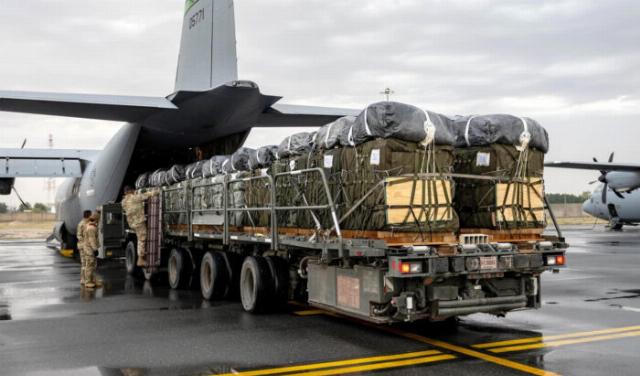
Loading LCADS-LV type PGS into an aircraft using a "K" type conveyor
Something similar happened to the US Armed Forces when they carried out humanitarian airdrops in Bosnia in 1993-94, when, due to the lack of the possibility of selecting and returning standard reusable army PGS, all stocks located in Europe were quickly used up. We had to print warehouses in the United States and urgently deliver the PGS to Europe. Then, during more than 2,700 flights, more than 18 thousand tons of cargo were dropped from an altitude of 3000-5400 m. This, by the way, prompted the United States to begin the development of single-use PGS, which accelerated with the beginning of hostilities in Afghanistan and Iraq, and the massive use of parachuting cargo to supply its troops and allied troops began.
An interesting way was used by the French in April 2024. From the A-400M aircraft of the German Air Force (the Germans did not use their PGS due to the lack of necessary supplies), four platforms were dropped, on which bundles of 14 100-kilogram PGS were placed, stacked in three rows in height. After separation from the ramp of the aircraft, the fastening links broke and the PGS flew in different directions, revealing their own cargo parachutes, on which further descent took place.
A bundle of 14 PGS on one platform in a German Air Force aircraft
In March-April 2024, cargo airdrops were carried out, in addition to the above countries, by transport aircraft of the Air Forces of Bahrain, Belgium, Great Britain, Germany, Indonesia, Spain, Qatar, Kuwait, Morocco and Singapore. But these countries sent their planes for a short period of time: one or two weeks, or even engaged on a one-time basis. For example, three C-130H aircraft of the Moroccan Air Force performed a long-range landing, taking off from the Kenitra Air base (AvB) (Morocco), and refueled in the air from the KS-130N tanker aircraft accompanying them. Their participation was limited to this.
At the same time, the Israeli authorities did not allow Turkish military transport aircraft to fly over their airspace and, accordingly, to carry out cargo dropings.
The main burden was borne by the transport aviation of the Air Forces of Jordan, the United States, Egypt and the United Arab Emirates. For example, since November 2023, Jordanian Air Force transport aircraft have flown over 230 sorties to drop cargo, including more than 70 independently without the participation of partner countries. In addition, the United States and Great Britain provided assistance by transferring cargo parachute systems from their stocks to other countries participating in the humanitarian landing of goods. For example, as of 03/01/2024, the United Kingdom transferred, mainly to Jordan, 582 CCGs, including managed planning ones. The UAE and Qatar provided great financial assistance, both in the purchase of goods themselves and PGS.

Types of military transport aircraft that performed parachuting: C-130 (of various modifications, including HC-130J search and rescue aircraft of the US Air Force, converted into transport), C-295, C-17 and A-400M. Mainly used by the Air Forces of nearby countries: Jordan, Egypt and Qatar. The flight time for American C-17 aircraft departing for landing from AVB Al-Udeid (Qatar) is 6 hours, and for C-130 aircraft operating from AvB Jordan – 2 hours.
The AvB organized the preparation of cargo for landing (installation on platforms and fastening of cargo, installation of PGS) and their loading into the aircraft. To speed up cargo handling, US specialists stirred the cargoes arriving on standard cargo pallets directly onto platforms with cellular shock absorbers. The size of American cargo pallets is almost the same as the platform used in the PGS. The loading of the prepared PGS into the aircraft was carried out using special "K" type transporters (only on AvB El-Udeid) or forklifts.
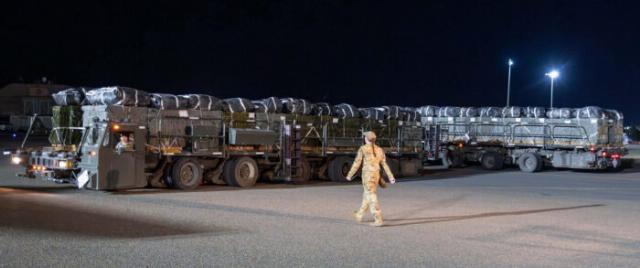
Prepared PGS on "K" type conveyors
The planes performed landing flights, as a rule, with incomplete loading. In many ways, this is due to the type of cargo being dropped. For example, US transport planes dropped a lot of ready-made food rations (so-called MRE, Meals Ready to Eat) in standard packaging: 12 rations in one box. 48 boxes are placed on a standard 122x122 cm PGS platform. According to the cargo labels, the flight weight of one LCADS-LV PGS was 568 kg. The C-17 aircraft usually loaded 30-32 such PGS, and the C-130J – 20. This is less than the maximum load. In addition, the use of domes from landing craft on the PGS limited their flight weight to 180 kg. The flight weight of a PGS with an A-21 container with one G-14 PS is 226 kg, with two – 453 (it was such PGS that were dropped by a Singapore Air Force transport aircraft).
It is not possible to accurately calculate the mass of dumped goods, because there is no single center where all the information would flow. Each participating country keeps its own records. It is known that in one group flight, military transport aircraft of the Egyptian and UAE Air Forces (as a rule, these are two C-17s from the UAE and one C-130H or two C-295 from Egypt) drop up to 82 tons of cargo. And in total, these countries, during the jointly conducted operation "Birds of Goodness", carried out 32 landings and dropped 2,025 tons of cargo during the period from February 29 to April 12, 2024.
The A-400M aircraft from the 15 VTAE of the Belgian Air Force made 9 landing sorties within two weeks, during which it dropped 216 CDS-type PGS with a flight weight of 183.7 tons (own weight of cargo – 164.3 tons). During one of the flights, he dropped 24.6 tons of cargo, which is slightly more than the estimated (24 tons) load of the aircraft.
Since January 2024, French military transport aircraft A-400M and C-130J have carried out 26 landings and dropped 110 tons of cargo.
The A-400M aircraft of the British Air Force landed 64 tons of cargo during seven sorties from March 25 to April 10, 2024. During the period from March 02 to April 11, 2024, the US military Transport Aviation carried out 29 cargo landings, during which 855 tons were dropped, including about 800 thousand tons. food rations, baby food, bottled water, and other products, as well as hygiene items and clothing.
The most massive landing sortie was conducted on April 09, when 14 transport aircraft from nine countries landed in various areas of the Gaza Strip on the occasion of the end of Ramadan celebrations. On this day, a British Air Force aircraft dropped 12 PGS with a total weight of 10 tons.
Features of cargo landing
The main method of dropping cargo is gravity.

Cargo landing over the Mediterranean coast
A special feature of humanitarian cargo landing is the lack of ground forces and support facilities that could designate landing sites and report weather conditions to incoming aircraft. The aircraft crews had to rely on preliminary weather information received during the preparation for departure, as well as data from the aircraft's onboard radars. This led to the fact that part of the PGS fell into the water, since the main landing sites were located on the Mediterranean coast. For example, during one of the landings conducted by the US air force on April 4 this year, 26 out of 80 dropped PGS landed at sea. And a few days earlier, almost all of them, about 60 dropped PGS, landed in the sea. And these are far from isolated cases.
PGS often landed among densely populated neighborhoods, damaging buildings and cars. Several landing PGS destroyed the antenna devices of solar panels on the roof of one of the hospitals. Social networks are full of such shootings.

Landing on a densely populated area of the Gaza Strip
The selection of goods was carried out spontaneously. Sometimes loads fell on crowds of people running to the place where they landed. This led to casualties. For example, on March 08, 2024, according to some foreign observers, five civilians, including one child, were killed during the landing. Civilians ended up in the center of the landing site and died as a result of falling descending cargo on them. Officials of the Central Command of the US Armed Forces expressed their condolences to the relatives of the victims, but stated that the US Armed Forces had nothing to do with this incident. Presumably, they were hit by LCADS-HV type PGS landing at high speed, which were dropped from UAE military transport aircraft.
On March 26, 2024, 18 Palestinians died while trying to pick up PGS that fell into the water, including 13 drowned, and the rest from landing cargo. There were cases when the PGS landed in places of combat operations, and those trying to pick up cargo were fired at by the Israeli army.

Destruction as a result of cargo landing
The main disadvantage of this method of delivering humanitarian goods is its high cost, compared with delivery by land or by sea. For example, according to calculations by foreign experts, the cost of delivering 1 kg of cargo to the Gaza Strip by land transport is 8-10 times cheaper than parachuting.
To be continued…
Based on the materials of the resources: aerotexsys.com, bhfwkj.com, sofrep.com, armyrecognition.com, voenoedelo.com, centcom.mil, afcentcom.mil
